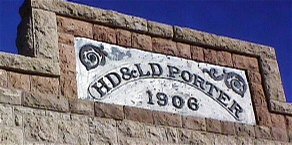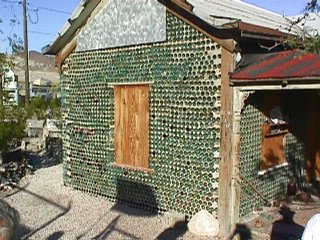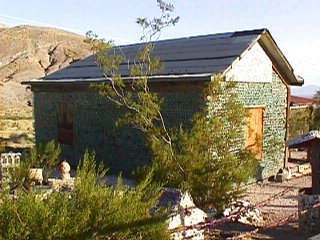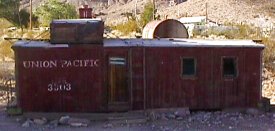

|
|
One of the many ghost towns both in and, in this case, around Death Valley. Rhyolite is just outside Beatty, (pronounced "bait-e" if you ever go there!) Nevada. Rhyolite was once called the Queen City of Death Valley and at its height had a population of 10,000. |
In 1904 Shorty Harris and E.L. Cross were prospecting in the area. They found quartz, full of gold, all over a hill. As Shorty described it, it was "...the original bullfrog rock..." and he predicted a large strike. Alone in the area, except for "Old Man" Beatty, a rancher who lived some five miles away, the registering of this claim started a big rush and several camps were set up in the area, including Bullfrog, the Amargosa, and a settlement between them (Jumpertown). Rhyolite was established at the claim site and was named from the silica-rich volcanic rock of the same name found in the area.

The town boomed. It had a stock exchange and Board of Trade. There were hotels, stores, a school capable of teaching 250 students, an ice plant, two electric plants, foundries, machine shops, and even a hospital. From as far away as San Francisco came women for the red light district.
|
|
|
Probably the most famous, and enduring, landmarks of Rhyolite was a Bottle House, built in 1906 by Tom T. Kelly out of 50,000 beer and liquor bottles. The house was protected until recently when it fell prey to some vandalism. It is now again protected and slowly being restored.


The bottle house, in addition to being an interesting architectural study, is something of a living history. By studying the marks on the various bottles you can tell what types of liquor had made it to Rhyolite and even, in one case, what fauna was there (one of the bottles has a preserved cricket inside it).
|
|
|
As soon as it began, however, the town started its decline. The 1907 financial panic was the start of the end and, in the next few years, both mines and banks closed. By 1910 production at the mill had declined significantly and the town only had 611 residents. March 14, 1911 the directors voted to close down the Montgomery Shoshone mine and mill and in 1916 the power was finally turned off in the town.

Other features of the Valley are documented on the next page in no particular order...
Comments? Please use the contact
page form.
Copyright © 2002
Tom Simondi, All Rights Reserved